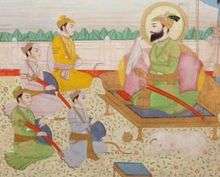Ajit Singh (Sikhism)

Ajit Singh (26 January 1687 – 7 December 1705), also referred to with honorifics as Sahibzada Ajit Singh or Baba Ajit Singh, was the eldest son of Guru Gobind Singh. His younger brothers were Sahibzada Jujhar Singh, Sahibzada Zorawar Singh and Sahibzada Fateh Singh. He was killed during the Second Battle of Chamkaur.[1]
Early life
Ajit Singh was born to Mata Sundari and Guru Gobind Singh at Paonta Sahib on 26 January 1687.[1] He was brought up in Anandpur, where his education included religious texts, history and philosophy. He received training from Baba Jeevan Singh (Bhai Jaita) in riding and the martial arts of swordsmanship and archery.
Battles
The Ranghars of Nuh
He was given his first military assignment when barely 12 years old. A Muslim tribe, the Ranghars of Nuh, had attacked and looted a Sikh Sangat (congregation) coming from the Pothohar region of northwest Punjab. Guru Gobind Singh sent Ajit Singh in command of 100 men to the village, which was a short distance from Anandpur across the River Satluj. Ajit Singh reached the village on 23 May 1699, recovered the looted property and punished the offenders.[1]
Anandpur and Nirmohgarh
In 1700 Anandpur was attacked by hill chiefs assisted by troops provided by the Mughal faujdar of Sirhind. Guru Gobind Singh had erected five Qila (forts) on the outskirts of the city. Ajit Singh, assisted by Bhai Udai Singh, a seasoned soldier, was put in charge of the defence of the Qila Taragarh Sahib. On 29 August the hill chiefs made the fort the target for their first attack, which was successfully repulsed. For four days the chiefs attacked the fortresses around the citadel, without success.[1]
He also fought valiantly in the Battle of Nirmohgarh (1702). On 15 March 1701, a Sikh Sangat coming from the Darap area (near Sialkot) was waylaid by Gujjars and Ranghars. Sahibzada Ajit Singh led a successful expedition against them.
Restoring a Brahmin's wife
Battle of Bassi Kalan
In March 1703, Dewki Das, a Brahmin came to Anandpur and requested the Guru to help him in getting back his wife whom Chowdhry Jabar Khan, the chief of Dera Bassi, had taken away forcibly; the Guru asked Sahibzada Ajit Singh and Bhai Udey Singh to help the Brahmin. On the 7th of March 1703, both of them, joined by about one hundred Sikhs, went to Bassi Kalan; they put siege to the village and sent a message to Jabar Khan to return the Brahmin's wife; but Jabar Khan, instead of returning the Brahmin’s wife, asked his soldiers to attack the Sikhs; it was followed by a full-fledged battle, in which Jabar Khan was killed; the Brahmin's wife was restored to him. When this news reached the people, they praised the Sikhs for their role.[2]
Second Battle of Chamkaur
When Mughal forces besieged Anandpur in 1704, Sahibzada Ajit Singh again displayed his qualities of courage and steadfastness. After a long stalemate, the Mughal Faujdar gave his assurances that he only wanted the fort of Anandpur and would let the population of the town go unharmed. Anandpur was vacated on the night of 5th and 6 December 1704. Sahibzada Ajit Singh was given the command of the rearguard. As the besiegers, violating their solemn promises, attacked the column, he stoutly engaged them on a hill-feature called Shahi Tibbi until he was relieved by Bhai Udai Singh. Ajit Singh crossed the Sarsa rivulet, then in spate, along with his father, younger brother, Jujhar Singh, and some others. Further reduced in numbers by casualties at the hands of pursuing troops from Ropar, the column reached Kotla Nihanga and then proceeded to Chamkaur on the night between 6th and 7 December 1704. There they rested for some hours in the fortress of Budhi Chand Rawat.[3] But, in the afternoon the Muslim soldiers from Malerkotla and Sirhind reached there, surrounded the fortress, and threw a tight ring around it. The Sikhs too took up position. An unequal but grim battle began. The Sikhs had exhausted the meagre stock of ammunitions and arrows, hence they made sallies in batches of five each to engage the encircling host with sword and spear.
Sahibzada Ajit Singh led one of the sallies and laid down his life fighting in the thick of the battle. Gurdwara Katalgarh now marks the spot where he fell, followed by Sahibzada Jhujhar Singh who led the next sally. An annual fair is held in the commemoration of their martyrdoms in December - January.
Commemoration
Ajitgarh, one of the largest cities in Punjab lying adjacent to its capital Chandigarh, has been named in the memory of Sahibzada Ajit Singh, Ajitgarh ('Home of Ajit'). It is located in the district of the state which is also named after him Sahibzada Ajit Singh Nagar District.[4]
See also
References
- 1 2 3 4 Ashok, Shamsher Singh. "AJIT SIHGH, SAHIBZADA (1687-1705)". Encyclopaedia of Sikhism. Punjabi University Punjabi.
- ↑ Dr Harjinder Singh Dilgeer, THE SIKH REFERENCE BOOK, The Sikh University Press, 1997
- ↑ Harjinder Singh Dilgeer, Sikh History in 10 Volumes, vol. 1
- ↑ "Mohali is now Ajitgarh". Retrieved 2012-08-09.
Further reading
Singha, H.S. (2009). The encyclopedia of Sikhism. Hemkunt Press. p. 32. ISBN 978-81-7010-301-1.